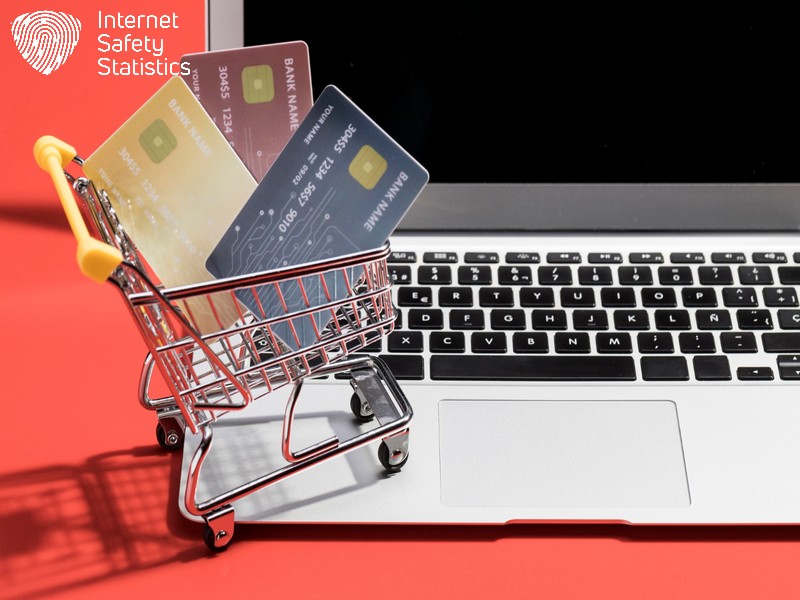
The convenience of online shopping is undeniable, but navigating the digital marketplace requires vigilance. Fraudulent activity threatens secure online transactions. Fortunately, adopting best practices during online transactions significantly reduces the risk of falling victim to cybercriminals.
This guide equips you with the knowledge to safeguard your hard-earned money when shopping online. We’ll explore essential security measures, from verifying website legitimacy and utilizing strong passwords to implementing two-factor authentication and monitoring your bank statements for suspicious activity. Following these steps can transform your online shopping experience into a secure and enjoyable journey.
Stay with us, and learn how to shop without worry!
Importance of E-commerce Security
E-commerce security is like a shield, protecting your personal and financial details during online shopping. Imagine typing in your credit card information, only for it to fall into the hands of hackers. This scenario underscores why safeguarding transactions is non-negotiable. Implementing SSL certificates keeps this sensitive data encrypted, ensuring that the bad guys can’t easily intercept what’s yours.
Businesses must prioritise choosing secure e-commerce platforms that stand up robustly against cyber threats. Compliance with PCI DSS security standards isn’t just a recommendation; it’s essential for defending customer payment information throughout the purchasing process.
Strong cybersecurity measures give shoppers peace of mind and help maintain trust in digital marketplaces. With these foundations firmly in place, we can focus on understanding potential threats to e-commerce security next.
Secure Online Transactions: Potential Threats
Cyber threats such as phishing, malware and ransomware pose significant risks to online transactions. Implementing security measures is crucial to protect against potential threats.
Phishing
Phishing attacks target personal and financial information by posing as legitimate entities. Emails, messages, or websites mimic trusted sources to lure victims into sharing sensitive details such as login credentials or payment information.
Cybercriminals exploit human trust and curiosity, making phishing one of the most prevalent forms of cybercrime. It’s crucial to be wary of unsolicited requests for personal information and scrutinise URLs and email addresses for authenticity. Implementing multi-factor authentication and staying informed about common phishing tactics are essential for safeguarding against these deceptive schemes.
Understanding the subtleties of phishing attempts is vital in preventing data breaches. By educating users on red flags like unexpected requests for confidential data or suspicious links, individuals can fortify their defences against online threats.
Malware and Ransomware
Malware and ransomware pose significant threats to e-commerce security. Malware, including viruses and spyware, can infect computers and compromise sensitive customer data. Ransomware encrypts files and demands payment for their release, causing businesses financial loss and reputational damage.
Implementing robust antivirus software is essential in detecting and preventing malware attacks. Similarly, regular backups of critical data can safeguard against the impact of ransomware. E-commerce businesses must remain vigilant against these sophisticated cyber threats by staying informed about the latest security measures.
SQL Injection
SQL injection is a serious threat to e-commerce security, where attackers insert malicious SQL code into entry fields on a website. This can lead to unauthorised access to the database, potentially compromising sensitive customer information and financial data.
Implementing strict input validation and parameterised queries can help prevent SQL injection attacks. Regularly updating software and conducting security audits are crucial in detecting and preventing vulnerabilities that could be exploited through SQL injection.
Implementing best practices, such as using prepared statements with parameterised queries, helps protect against SQL injection attacks. E-commerce businesses must stay informed about the latest security threats and ensure their online platforms are equipped with robust defences against SQL injection risks.
Cross-site Scripting (XSS)
Cross-site Scripting (XSS) is a prevalent cyber threat affecting e-commerce. Hackers inject malicious scripts into webpages, allowing them to access users’ personal information like login credentials or financial data.
This can occur when users interact with compromised websites, making it crucial for businesses to stay vigilant and regularly update their security measures. Implementing strict input validation, using content security policy headers, and employing web application firewalls effectively protect against XSS attacks.
Ensuring online safety requires understanding the types of e-commerce security threats and taking proactive steps to counter them. Businesses must prioritise implementing robust defences against XSS attacks as part of an overall strategy to safeguard sensitive customer data during online transactions.
E-Skimming
Protecting your online transactions also means safeguarding against E-skimming, a malicious method cybercriminals use to steal payment card data during online transactions. This tactic involves inserting skimming code into a website’s checkout page or payment processing system, allowing attackers to capture sensitive financial information as customers enter it.
With the rise of E-skimming attacks, businesses and individuals must remain vigilant in implementing robust security measures and staying informed about the latest threats to e-commerce security.
E-Skimming poses a significant risk to online shoppers’ confidential data, making it essential for e-commerce businesses to prioritise cybersecurity strategies encompassing encryption, secure payment gateways, and regular security updates.
Best Practises for E-commerce Safety

The best practises to ensure the security of your online transactions include choosing a secure e-commerce platform, implementing SSL certificates and multi-factor authentication, staying educated and training employees, using a VPN, and keeping software and platforms up-to-date to protect your online transactions.
Choose a Secure E-commerce Platform
What defines a secure e-commerce platform? When choosing which platform to entrust your monetary information to, there are various characteristics to consider. You must inspect the platform’s security measures and possible authentication techniques.
- Opt for a platform that offers regular security updates and patches to safeguard against emerging threats.
- Look for a platform with robust payment security features like end-to-end encryption and fraud prevention tools.
- Consider platforms with built-in compliance standards like PCI-DSS to protect sensitive customer data during transactions.
- Choose a platform that offers secure hosting options and data encryption to prevent unauthorised access to customer information.
- Select a platform with strong user authentication measures, such as multi-factor authentication, to add a layer of security for user accounts.
Implement SSL Certificates
Implementing SSL certificates is crucial for encrypting data transmitted between users and web servers to ensure sensitive information remains secure. Here are some essential details about implementing SSL certificates:
- SSL (Secure Sockets Layer) certificates create a secure connection between a web browser and the server, ensuring that all data transferred is encrypted and protected from unauthorised access.
- By installing an SSL certificate on your website, you provide visitors with a visual indicator, such as a padlock icon or HTTPS prefix in the URL, indicating that their connection is secure.
- When choosing an SSL certificate, consider the level of validation required—domain validation (DV), organisation validation (OV), or extended validation (EV)—based on your security needs.
- Remember that having an SSL certificate secures user data and improves your website’s search engine ranking, as Google prioritises websites with HTTPS in search results.
- Finally, regularly check and renew SSL certificate expiration dates before they expire to ensure uninterrupted security for your e-commerce website.
Use Multi-factor Authentication
Another vital aspect of securing online transactions is using multi-factor authentication to complement implementing SSL certificates. This involves the use of two or more forms of identification to verify a user’s identity before granting access to an account or conducting a transaction. This additional layer of security significantly reduces the risk of unauthorised access to sensitive information and accounts.
- Unique Login Credentials: Require users to provide a password and a second verification form, such as a one-time code sent via text message or email.
- Biometric Authentication: Implement biometric methods like fingerprint or facial recognition for an added layer of security, making it difficult for unauthorised individuals to gain access.
- Hardware Tokens: Offer hardware tokens that generate temporary codes to verify a user’s identity when logging in or making transactions.
- Time-based One-Time Passwords (TOTP): Enable TOTP apps to generate temporary codes, providing an extra level of authentication on top of traditional passwords.
- Risk-based Authentication: Utilise intelligent systems that assess factors such as location, device, and behaviour patterns to determine if additional authentication measures are necessary based on potential risk factors.
Stay Educated and Train Employees

Keep updated with the latest cybersecurity threats and trends in the e-commerce industry to protect your online transactions and business from potential risks.
- Regularly conduct training sessions for employees to increase awareness of cybersecurity threats specific to e-commerce, including phishing, malware, and other fraudulent activities.
- Provide resources and materials that empower employees to recognise and respond effectively to potential security risks during online transactions.
- Emphasise the importance of maintaining strong passwords, identifying suspicious activities, and following established security protocols when handling customer data or processing transactions.
- Foster a culture of vigilance by encouraging employees to promptly report any unusual or potentially threatening online activities or communications.
- Stay updated with industry standards and compliance regulations concerning e-commerce security, ensuring that your team is equipped to adhere to these guidelines effectively.
- Utilise case studies or real-life examples of e-commerce security incidents as part of employee training initiatives to illustrate potential risks and promote a proactive approach to security measures.
- Encourage open communication channels within the organisation regarding any cybersecurity concerns or questions, promoting a collaborative approach towards addressing potential threats.
- Collaborate with IT professionals or external experts for specialised training sessions tailored to the unique security challenges associated with e-commerce transactions.
- Implement regular assessments or tests to evaluate employees’ understanding of e-commerce security protocols and tailor future training initiatives based on areas of improvement identified through these evaluations.
- Monitor emerging trends in cyber threats related to online transactions and adapt your training programmes accordingly, ensuring your team remains well-informed about evolving risks in the e-commerce landscape.
Use a VPN
To enhance your online security, consider using a Virtual Private Network (VPN) to safeguard your sensitive information. A VPN creates a secure connection between your device and the internet, protecting your data from threats like hackers and snoopers.
- Encrypts Your Data: A VPN encrypts the data transmitted between your device and the internet, ensuring that any sensitive information you send or receive remains secure and confidential.
- Protects Your Privacy: By masking your IP address, a VPN helps protect your online privacy by preventing websites, advertisers, and even your internet service provider from tracking and monitoring your online activities.
- Bypasses Geo-Restrictions: With a VPN, you can access region-locked content and websites that may be restricted in your location, providing greater access to online resources and services.
- Secures Public Wi-Fi Connections: Using a VPN when connected to public Wi-Fi networks adds an extra layer of security, safeguarding your data from potential cyber threats on unsecured networks.
- Shields Against Cyber Threats: By routing your internet traffic through a secure server, a VPN protects against malware, phishing attempts, and other online threats.
Keep Software and Platforms Up-to-date
Upgrade your online security by ensuring your software and e-commerce platforms are always up-to-date. This helps in plugging security loopholes that cybercriminals could exploit. Here’s how you can do it:
- Regularly install updates for your operating system, web browsers, and other online transaction software.
- Set up automatic updates to ensure you don’t miss any crucial security patches or bug fixes.
- Keep your e-commerce platform updated with the latest security features and enhancements to safeguard customer data.
- Check for weekly updates to stay protected from newly discovered vulnerabilities in software and platforms.
- Utilise secure, trusted sources for downloading and updating software to avoid potential malware or ransomware threats.
How to Protect Your E-commerce Business from Fraud
Enable fraud protection tools, pair CAPTCHA with a hosted payment form, maintain PCI compliance, monitor transactions and reconcile accounts, and stay educated on the latest fraud tactics to keep your e-commerce business safe from fraudulent activities.
Enable Fraud Protection Tools
Protect your online transactions by enabling fraud protection tools, crucial in safeguarding your e-commerce business. These tools help to identify and prevent fraudulent activities, ensuring secure and reliable online transactions. By implementing these measures, you can protect your customer’s sensitive payment information and uphold the integrity of your business. Here are key fraud protection tools to consider:
- Implement Real-time Transaction Monitoring: Utilise advanced monitoring systems that can detect suspicious activities, unusual transaction patterns, and potential fraud in real-time.
- Integrate Address Verification Service (AVS): This tool validates customers’ billing addresses against the ones registered with their credit card company, helping to detect any discrepancies.
- Employ Device Fingerprinting: Use device fingerprinting technology to uniquely identify devices used for transactions, aiding in identifying fraudulent activity across different transactions.
- Utilise Geolocation Services: Implement geolocation services to verify the physical location of users during transactions, reducing the risk of fraudulent orders originating from high-risk locations.
- Set Up Automated Fraud Scoring: Employ automated scoring systems that assign risk scores to transactions based on transaction history, customer behaviour patterns, and other risk indicators.
Pair CAPTCHA with Hosted Payment Form
To enhance the security of online transactions, it is crucial to pair CAPTCHA with a Hosted Payment Form. This additional security measure helps prevent automated bots or malicious software from making unauthorised transactions. By implementing CAPTCHA alongside the Hosted Payment Form, businesses can significantly reduce the risk of fraudulent activities and protect customers’ sensitive payment information.
- Safeguard Against Automated Attacks: CAPTCHA presents a challenge-response test to confirm that the user is a human, not a bot. This prevents automated attacks and ensures that only legitimate users can proceed with the transaction.
- Prevent Unauthorised Access: When combined with a Hosted Payment Form, CAPTCHA adds an extra layer of security to prevent unauthorised access by requiring users to solve a challenge before proceeding with the payment process.
- Reduce Fraudulent Activities: Integrating CAPTCHA with Hosted Payment Forms helps reduce the risk of fraudulent activities such as unauthorised transactions, stolen credit card information, and other forms of online payment fraud.
- Enhance User Verification: CAPTCHA verification alongside the Hosted Payment Form enhances user verification, ensuring that only genuine customers can complete their transactions securely.
- Improve Overall Transaction Security: By pairing CAPTCHA with a Hosted Payment Form, businesses can improve the overall security of their e-commerce platform and provide customers with added confidence in the safety of their online transactions.
Maintain PCI Compliance

Payment Card Industry, or PCI, is a guideline that ensures that any industry that stores, manages or transmits user payment information complies with specific guidelines to ensure the safety of such information.
- Regularly conduct security assessments to identify and address vulnerabilities in your payment processing systems.
- Implement strong access control measures to restrict unauthorised access to sensitive payment data, including limiting employee access based on job functions.
- Encrypt cardholder data during transmission and storage, adhering to encryption protocols outlined in the PCI-DSS standards.
- Regularly update and patch systems, applications, and devices to protect against known vulnerabilities and security threats.
- Maintain a comprehensive information security policy outlining the organisation’s approach to protecting payment card data and ensuring employees know their responsibilities.
- Keep detailed records of all security policies, procedures, and system configurations to maintain compliance with PCI-DSS requirements.
- Conduct regular security awareness training for employees handling payment card data, emphasising the importance of safeguarding sensitive information and recognising potential security risks.
Monitor Transactions and Reconcile Accounts
To protect your online transactions, it is crucial to monitor all transactions and regularly reconcile your accounts. Here’s how you can do this:
- Regularly review all incoming and outgoing transactions to identify unauthorised or suspicious activity.
- Utilise financial management tools or software to automate the process of reconciling accounts.
- Compare transaction records with bank and credit card statements to ensure accuracy and detect discrepancies.
- Investigate any inconsistencies or unfamiliar charges promptly to address potential fraudulent activities.
- Keep detailed records of all transactions and reconciliation efforts for future reference and auditing purposes.
Stay Educated on Latest Fraud Tactics
Educating yourself about the latest fraud tactics is crucial to safeguarding online transactions. By staying informed, you can recognise new threats and take proactive measures to protect your sensitive information. Understanding evolving fraud tactics will empower you to make informed decisions and avoid falling victim to cybercriminals.
Awareness of the ever-changing landscape of fraudulent activities is essential for maintaining secure online transactions. Stay updated on the latest fraud tactics to stay one step ahead of potential security breaches that could compromise your financial or personal data.
Protecting your online transactions is crucial for e-commerce safety. Stay vigilant against cyber threats and implement essential security measures to safeguard your business and customers. By prioritising online transaction security, you can ensure a safe and secure shopping experience for everyone involved. Take charge of your e-commerce security today!
FAQs
1. Why is e-commerce security important for online shopping?
E-commerce security is vital to protect your digital identity, keep your transactions confidential, and prevent fraud while you enjoy secure online shopping.
2. How can I ensure the payment processing is secure when buying online?
Ensure the website uses secure payment methods and confirms that multifactor authentication is in place for added protection during payment processing.
3. What steps can businesses take to prevent e-commerce fraud?
Businesses should adopt a strong e-commerce security strategy, including cybersecurity measures such as two-factor authentication and phishing protection, to defend against fraudulent activities.
4. Are there specific tips for customers to stay safe while shopping online?
Yes! Always use trusted websites, set up two-factor authentication where possible, and be vigilant about phishing attempts—these are key cybersecurity tips for staying safe during online shopping.
5. Can using different forms of verification help with transaction safety in e-commerce?
Absolutely! Multifactor authentication adds layers of security, ensuring only you can make transactions or changes, significantly reducing the risks of unauthorised access in e-commerce environments.
